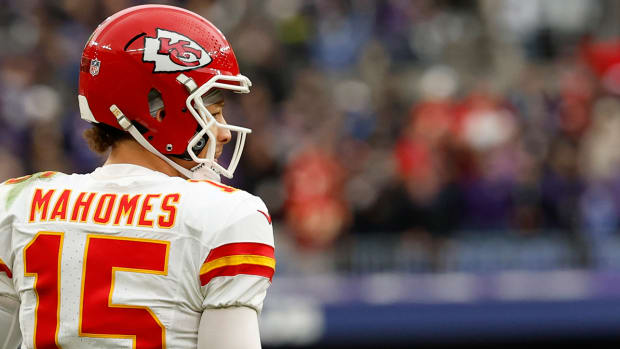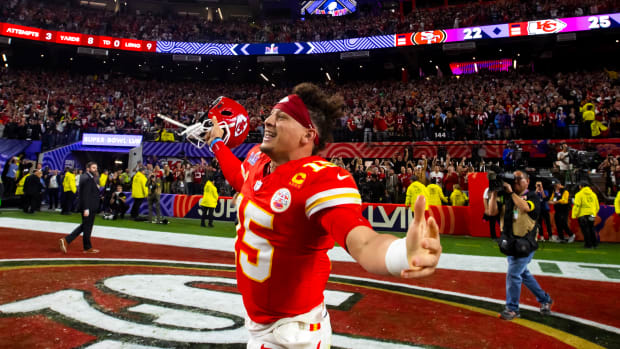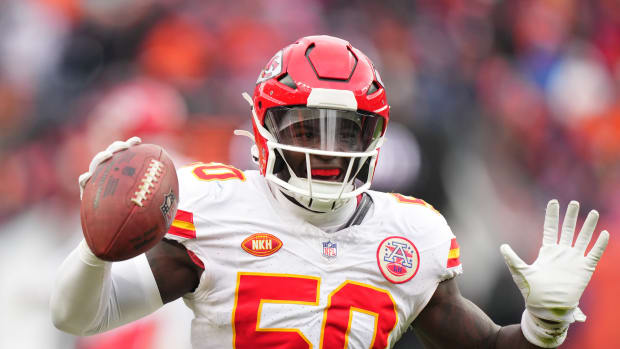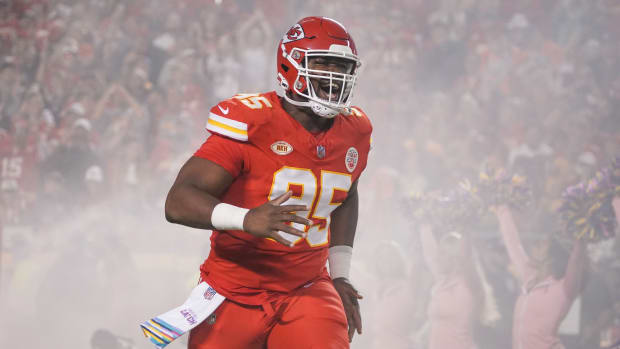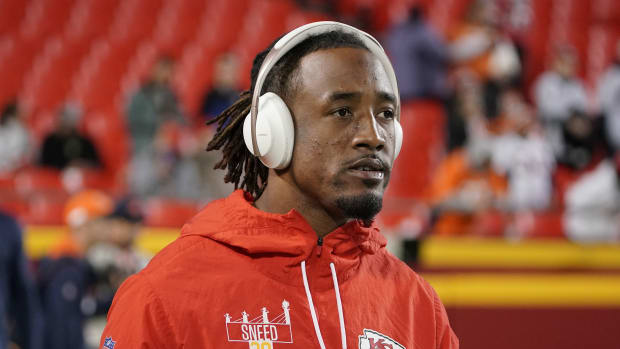Analytics and revolutions: Why Andy Reid wanted Clyde Edwards-Helaire
For as long as I’ve been a sports fan, I’ve believed in “analytics” — “the discovery, interpretation, and communication of meaningful patterns in data.” Growing up, I preferred reading to running and thinking to throwing, so when Carlos Beltran’s walk-off home run against the White Sox on Opening Day 2004 ignited in me an instant, inexplicable obsession with baseball, the first thing I did was buy a book. The book was Michael Lewis’s Moneyball - a treatise on the Oakland Athletics’ use of analytics to win baseball games in a small market, since adapted to a feature film starring Brad Pitt - and it left me firmly convinced that analytics are essential to a sports team achieving long-term success.
For as long as I’ve been a football fan, I’ve believed in Andy Reid. Having taken to heart a famous Billy Beane quote from Moneyball: “My job is to get us to the playoffs. Everything after that is f---ing luck.” I always put more stock in Reid’s year-in, year-out consistency in the regular season than in his many, well-publicized playoff failures. It helped that Andy Reid was something of a darling to the analytics community, to which I remained a devotee. Analytics say that passing the football is more efficient than running the ball; Andy Reid’s offenses were regularly among the pass-happiest attacks in the NFL. Pro Football Focus named Andy Reid the best offensive play-caller in the NFL. Football Outsiders’ DVOA metric had the Chiefs ranked top 10 in offensive efficiency every year since 2014. Analytics could even, on some level, quantify Reid’s offensive genius.
On February 2, 2020, my belief in Reid was validated, as Big Red led the Chiefs to their first Super Bowl win in 50 years. Then, less than two months later, on April 23, 2020, Reid did something so unexpected, so out of character, that I didn’t know what to believe.
He took Clyde Edwards-Helaire, a running back, in the first round of the NFL Draft.
For years, the analytics community and the Chiefs’ front office seemed to be in lock-step on one thing more than anything: that running backs don’t matter. Evidence suggests that investing high picks on running backs in the NFL Draft returns poor value. Andy Reid had never, in his 20-plus years as an NFL head coach, drafted a running back higher than 53rd overall (LeSean McCoy in 2009, while still with the Philadelphia Eagles), and never higher than 86th overall with the Chiefs (Kareem Hunt in 2017).
The analytics community also strongly counseled against signing running backs to big contracts — and took a victory lap when the Los Angeles Rams recently released Todd Gurley one season into a four-year, $60 million deal, leaving L.A. with $17.25 million in dead cap. But the Chiefs have never spent lavishly at the running back position, ranking just 15th in spending at the position in 2019 per Over The Cap. They were 26th in 2018, and 22nd in 2017 and 2016. Even last year, their investment at the position was spread across multiple backs: LeSean McCoy, at $3 million the Chiefs’ highest-paid running back, was the 20th highest-paid running back in the NFL in 2019; Damien Williams, at $1.73 million, was the 35th highest-paid back. The total draft capital invested by the Chiefs in their 2019 running back room? A single sixth-round pick, on rookie Darwin Thompson. Every other back was a free agent signing.
That the Chiefs won the Super Bowl with such a minimal investment at running back seemed to prove the analytics community right. Further, it suggested that the Chiefs agreed with the analytics community on the value of running backs. When they added DeAndre Washington in free agency and exercised Damien Williams’ club option, it certainly seemed that the Chiefs were content to enter the 2020 season with a committee of modestly talented (and modestly paid) backs. I was so confident that the Chiefs would not go running back in the first round that I vowed to eat a tweet if they did so.
Then the Chiefs took Clyde Edwards-Helaire, a running back, in the first round of the NFL Draft.
Pro Football Focus captured the general tenor of the analytics community when they declared “Clyde Edwards-Helaire projects as a good player and bad value for the Chiefs.” The critical reception to the pick has nothing to do with Edwards-Helaire’s ability, and everything to do with the position that he plays. Running the ball isn’t as efficient as passing the ball, and NFL teams are running the ball less. The shelf lives of running backs are short. Even great running backs require functional offensive line play to produce at a high level, and a great offensive line can elevate even the most pedestrian backs to Pro Bowl-level production. A team is never “one player away” from a Super Bowl if that one player is a running back. I believe all of these things.
Still, it would be too easy to simply dismiss Edwards-Helaire as “bad value” for the Chiefs. The Chiefs’ front office, while certainly not infallible, is obviously very good at evaluating NFL talent. This time last year, the Chiefs were widely criticized for not adding to their cornerback room.
That cornerback room was part of a defense that rose from 26th in defensive DVOA and 24th in points allowed per game in 2018 to 14th in DVOA and seventh in points allowed in 2019. Part of the reason a running back represents “bad value” in the first round is because of the opportunity cost, and the Chiefs could’ve added cornerbacks Jaylon Johnson, Kristian Fulton, or Trevon Diggs, all of whom were taken in the second round before the Chiefs’ next pick, at 63rd overall. But the Chiefs, having already demonstrated that they value the position differently than draftniks, decided for the second straight year not to invest a premium pick there, waiting until the fourth round to snag L’Jarius Sneed. And who can blame them? Last year, they took a widely mocked group of cornerbacks and won the Super Bowl.
The Chiefs’ unconventional strategy at cornerback — scorned, but ultimately successful — doesn’t make their pick of Edwards-Helaire above criticism. But it does make it harder to dismiss out of hand that the Chiefs don’t know what they’re doing here. Andy Reid had never taken a running back in the first round before. To invest that pick in Edwards-Helaire must have required a special set of circumstances. What were those?
First, and most obviously, the Chiefs did not have many holes in their roster. They return 20 of 22 starters from a team that won the Super Bowl, and that’s not counting their superlative rookie safety Juan Thornhill, who got hurt in the Chiefs’ final regular-season game, but should return in 2020. The Chiefs’ linebacker unit was amongst the worst in the NFL last season, but the Chiefs still won the Super Bowl, because linebacker, like running back, isn’t a terribly important position. In any case, the Chiefs drafted a linebacker, Willie Gay Jr., with their second-round pick, to largely positive reviews.
Second, it’s clear that the Chiefs view Edwards-Helaire as a special player. Part of the reason running backs aren’t highly valued in the modern NFL is because running the ball isn’t highly valued in the modern NFL. Rushing the ball is still important, and has its place, but the days of “three yards and a cloud of dust” offenses are thankfully gone. Where a back can add the most significant value, though, is as a receiver, and there, Edwards-Helaire has significant experience:
Even an elite receiving back isn’t adding as much “value” as an elite wide receiver or tight end, though, because of the nature of running back targets. Because the majority of running back targets are coming close to the line of scrimmage, where a completion is relatively unlikely to go for a big gain, their targets typically aren’t as valuable. Unless, as we saw above, your head coach is Andy Reid:
The Chiefs are adding an elite receiving back who can also run the ball at a high level. And that’s the third piece of Edwards-Helaire’s value to the Chiefs: versatility. It got less press than the Chiefs’ pick, but the Eagles — a team already paying Carson Wentz over $100 million — drafted quarterback Jalen Hurts in the second round, with apparent plans to play him in special packages. The New Orleans Saints paid over $20 million to retain their Swiss Army Knife, Taysom Hill, for another two years. And the San Francisco 49ers, the Chiefs’ opponent in Super Bowl LIV, pay fullback Kyle Juszczyk almost twice as much money as any other fullback in the NFL.
I can’t tell you how the Chiefs plan to use Edwards-Helaire, because I’m not Andy Reid. But it’s obvious that the Chiefs — and other very smart offensive minds — value versatility in their offenses in a way that can’t fully be captured by analytics. The Chiefs already had the most explosive player in the NFL, Tyreek Hill, capable of lining up at any receiver position, or in the backfield; the most prolific receiving tight end in the NFL, who has also taken snaps at running back in short-yardage situations, Travis Kelce; another 4.2 40-yard dash threat in Mecole Hardman; a big, explosive (when healthy) threat in Sammy Watkins; and other pieces like Damien Williams and Demarcus Robinson. To that, they add a dynamic runner and receiver in Edwards-Helaire. The ceiling of the Chiefs’ offense, with this new threat, is somewhere in low orbit - of the moon.
Based on past data, analytics can tell us that running backs drafted in the first round have not, historically, returned good value. But this data is only of so much use when applied to the Chiefs’ pick of Edwards-Helaire. The Chiefs didn’t draft a running back because they had to — they drafted a running back because they wanted to. One of the greatest offensive minds in NFL history, Andy Reid — the same Andy Reid who saw something in a big-armed quarterback with bad footwork playing college ball at Texas Tech — made Clyde Edwards-Helaire the first running back he’d ever selected in the first round in two decades as an NFL head coach.
Analytics can’t predict a revolution. But I think Andy Reid has a revolution on his mind.
